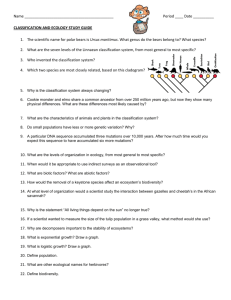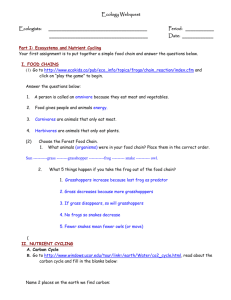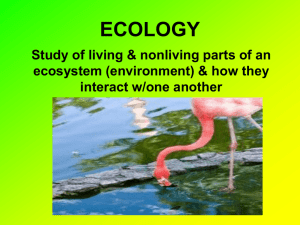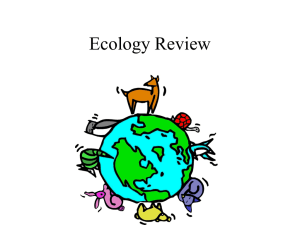APES Review Sheet - Liberty Union High School District
advertisement
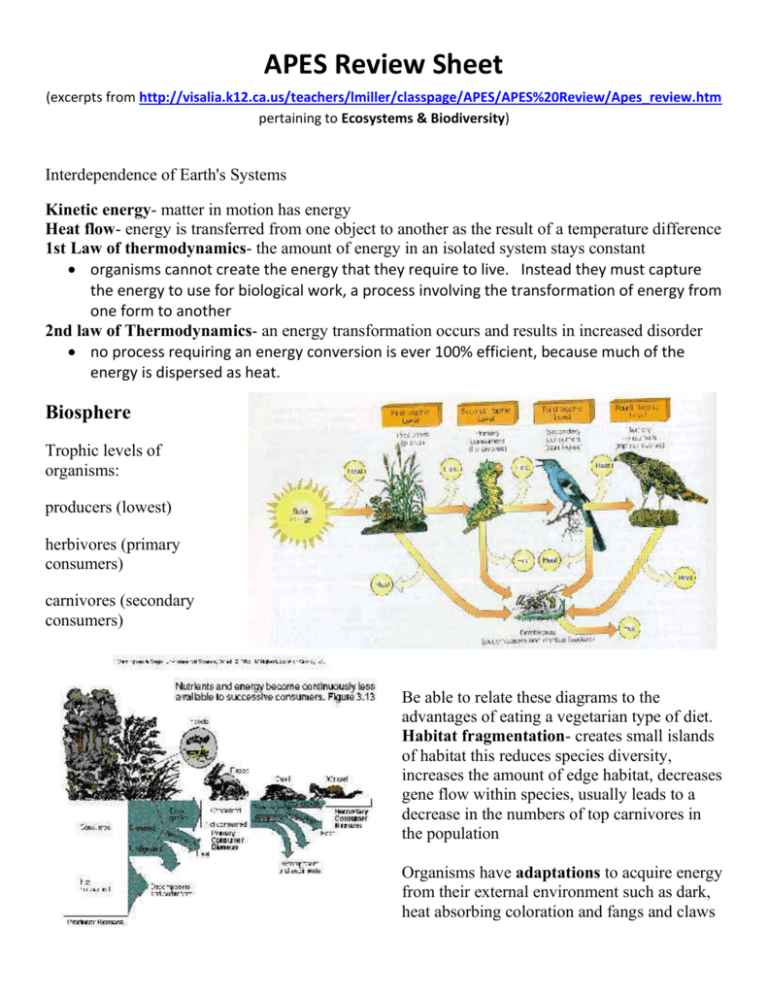
APES Review Sheet (excerpts from http://visalia.k12.ca.us/teachers/lmiller/classpage/APES/APES%20Review/Apes_review.htm pertaining to Ecosystems & Biodiversity) Interdependence of Earth's Systems Kinetic energy- matter in motion has energy Heat flow- energy is transferred from one object to another as the result of a temperature difference 1st Law of thermodynamics- the amount of energy in an isolated system stays constant organisms cannot create the energy that they require to live. Instead they must capture the energy to use for biological work, a process involving the transformation of energy from one form to another 2nd law of Thermodynamics- an energy transformation occurs and results in increased disorder no process requiring an energy conversion is ever 100% efficient, because much of the energy is dispersed as heat. Biosphere Trophic levels of organisms: producers (lowest) herbivores (primary consumers) carnivores (secondary consumers) Be able to relate these diagrams to the advantages of eating a vegetarian type of diet. Habitat fragmentation- creates small islands of habitat this reduces species diversity, increases the amount of edge habitat, decreases gene flow within species, usually leads to a decrease in the numbers of top carnivores in the population Organisms have adaptations to acquire energy from their external environment such as dark, heat absorbing coloration and fangs and claws Biomes Tundra Antarctic environment is very fragile and extremely vulnerable to the disturbances that would accompany development in this biome Tropical Rain Forest biome with the most biodiversity. Soils do not have many nutrients in them the majority of the nutrients are tied up in the canopy. If the trees are removed, the soils are depleted of nutrients quickly. Location where there is the greatest biodiversity remaining: Tropical rainforests of South America. When you lose diversity, there is an increased susceptibility to plant diseases Desert most of the earth's deserts are approximately 30o latitude north and south because these latitudes are characterized by descending dry air currents Desertification is occurring most rapidly along the fringes of the Sahara Desert in Africa since nomadic people who aren't using the land wisely are depleting the soils and turning it into desert Species Interactions commensalism- + 0 like moss growing on a tree parasitism- + - ticks feeding on a deer mutualism- + + bees and flowers predation- lion eating an antelope on the savannah competition- starling displacing bluebirds Symbiosis (Symbiotic relationships) Mycorrhizae mutualistic relationship between fungi and the roots of about 80% of all plants. Evolution is indicated by a population changing not an individual. A good example of the process of evolution would be a population of mosquitoes developing resistance to a pesticide, or a population of microbes developing resistance to a particular antibiotic. Biomass pyramids, energy pyramids GPP: gross primary productivity-rate at which energy is captured during photosynthesis NPP: Net primary productivity is the amount of biomass found in excess of that broken down by a plant's cell respiration or amount of matter incorporated into the plant tissue keystone species-crucial in determining the nature and the structure of the entire ecosystem. For example fig trees are keystone species in the tropical rain forests in Peru. Monkeys, fruit eating bats and other vertebrates eat figs when other fruits are in low supply II B. Cycling of Matter Important inorganic compounds include water and salts Limiting Factors ecotones- transitional zones where two or more communities meet. edge effect change in species composition produced by ecotone Biogeochemical cycles Carbon Cycle The two major processes involved in the carbon cycle are photosynthesis and respiration Carbon makes up .03% of the atmospheric gas, it is carbon dioxide is dissolved in the ocean, present as carbonate and tied up in limestone. A lot of carbon leaves the carbon cycle for millions of years incorporated into the shells of marine organisms . When the organisms die, their shells sink to the ocean floor and are covered by sediments and form limestone. Photosynthesis and Respiration cycle the carbon Nitrogen cycle Nitrogen fixation bacteria< Rhizobium. live in the nodules of leguminous plants such as peas and clover-mutualism. nitrogen fixation- the conversion of atmospheric nitrogen to ammonia, performed by nitrogen fixation bacteria nitrification- the conversion of ammonia to nitrate, performed by nitrifying bacteria assimilation- the conversion of inorganic nitrogen to organic molecules of organisms ammonification- the conversion of organic nitrogen to ammonia performed by ammonifying bacteria denitrification- the conversion of nitrate to nitrogen gas performed by denitrifying bacteria Phosphorous Cycle Both carbon and sulfur have a gaseous stage at some point in their cycle. Phosphorous does not. Phosphorous does not exist in a gaseous state and therefore does not enter the atmosphere. It cycles from land to sediments in the ocean and back to land. LAWS: National Environmental Policy Act( NEPA) of 1969 requires all agencies responsible for a major federal project to file an environmental impact statement-The best way the protect endangered and threatened species is by protecting the habitat. Endangered Species Act of 1973 (ESA) seeks to identify all endangered species and populations and to save as much biodiversity. as possible regardless of its usefulness to humans. Migratory Bird Treaty Act- this act prevents the destruction of the habitat of non-game migratory bird species CITES Treaty- has been helpful in protecting endangered animals and plants by listing those species and products whose international trade is controlled Wilderness Act- any land designated as wilderness is to remain road less and free of development
